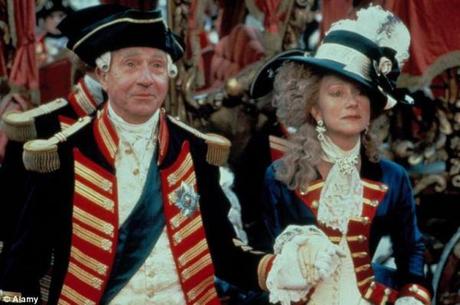
George III (Nigel Hawthorne) & Queen Charlotte (Helen Mirren) (www.dailymail.co.uk)
Movie-goers may fondly recall one of the finest costume dramas of years past, The Madness of King George. Directed by Nicholas Hytner, the 1994 film version of Alan Bennett’s stage play dramatized the plight of England’s eighteenth-century sovereign George III, magnificently enacted by the late Nigel Hawthorne, who repeated his successful stage role for the screen.
In particular, we remember how that same monarch — who lost the American colonies to a bold, grassroots rebellion — was suddenly struck down in the prime of life by a mysterious ailment, all the while behaving rather “irrationally,” to put it mildly, toward his wife, Queen Charlotte (a steadfast Helen Mirren), and her ladies in waiting, while spewing forth all-manner of childish prattle; then ultimately being “cured” by minister-turned-medic Dr. Willis (the no-nonsense Ian Holm, pre-Bilbo Baggins), who uses the most unconventional of methods then available to science, in a sort of physician’s mind-over-monarch approach.
In our more “enlightened” times, King George’s pet peeves, in fact, turned out to be a rare disease we know today as porphyria, an incurable affliction that attacks the body’s central nervous system. It manifests itself in various forms, including abdominal pain and tachycardia, as well as unreasonable behavior toward individuals and portentously dark urinary output. In the movie, the color of the king’s “water” is a rather unsettling shade of blue.
While all this is transpiring behind the scenes, the king’s indolent eldest son (also named George, and played in appropriate stiff-upper-lip fashion by a lazy-eyed Rupert Everett), is goaded into taking over his father’s throne by first having His Majesty declared a mental incompetent (good luck with that!), then attempting to assume the role of a “democratically” appointed regent by allying himself with his father’s opponents.
When The Madness of King George was first released, it was considered a fairly scathing commentary on Queen Elizabeth II’s dysfunctional royal family. Today, it bears closer scrutiny, for it depicts not only the disintegration from within of a fragile form of government (shades of the fractious U.S. Congress), but one that was entirely dependent upon the force and personality of a solitary, charismatic leader, i.e., the king himself.
That King George eventually recouped his wits, and came back, full-throttle, to lord it over his wayward son – and put down those poor unfortunates who came “this close” to fomenting outright rebellion against him – was not lost on modern movie audiences. Considering how our politicians have been behaving lately, maybe they should have their own urine output checked. Just in case…
Copyright © 2013 by Josmar F. Lopes

